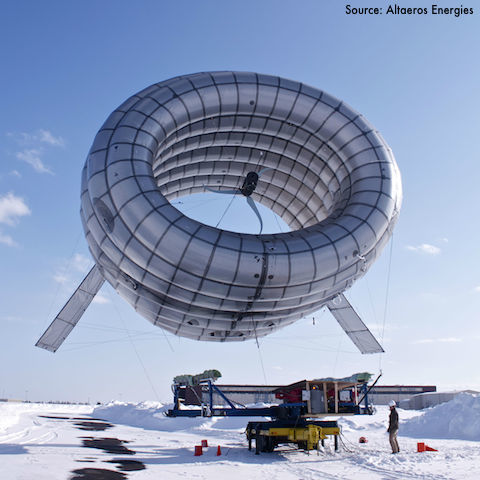
By Don Willlmott
Don Willmott is a New York-based journalist who writes about technology, travel, and the environment for a wide variety of publications and websites.
What the heck is that thing up in the sky? Go ahead and giggle if you want at the funny-looking blimp, but its purpose is no laughing matter. Altaeros Energies' Buoyant Airborne Turbine (BAT) is designed to go where no wind turbine has gone before: up to 2,000 feet in the air, where it can capture steady winds, turn them into electricity, and transmit power to the ground.
Why would anyone bother to float a wind turbine? Because it can be easily deployed in temporary workplaces, disaster zones, or any location where power generation isn't readily available or would be prohibitively expensive to install. And there's wind everywhere on the planet.
The BAT consists of a industrial fabric shell that's filled with 1,000 cubic meters of helium, a lightweight conventional three-blade wind turbine, high-strength tethers to hold it the turbine in place no matter the conditions (one tether contains copper wire to send the juice down to a battery), and a portable ground station the size of a shipping container that can be transported by truck. Four fins help keep it stable as it floats.

But the BAT is more than just a giant balloon on a string. The shell can also act as a platform for communication devices or sensor equipment. The turbine can work even at ground level. And the robotic tether control can automate its winches to adjust altitude and improve stability for optimal energy output. The power the BAT produces is conditioned on the ground station before it's sent to the grid.
The initial version of the BAT holds a 30-kilowatt turbine strong enough to power only about a dozen homes, but larger prototypes will carry a 200-kilowatt turbine. Both are designed to work optimally in 30 mph winds, but they can stay aloft until wind speed surpasses 75 mph.
Altaeros notes that the BAT is all about logistical ease, bringing power to places that have lost it, have never had it, or need it only on a temporary basis. The company isn't competing with permanently installed wind turbines; rather, it sees its main competition as the diesel generator. The idea has proved attractive enough to land a $7 million investment from Japan's Softbank and a $1.3 million grant from the Alaska Energy Authority to test the technology. It makes sense, since high-latitude locales where solar energy works well for just half the year could make ideal BAT sites. The first commercial Altaeros launch will take place this year in Fairbanks, Alaska, where even the small version of the turbine may compensate for 11,000 gallons of diesel fuel annually.
If that installation proves successful, it's a small leap to the bigger turbine, which could find use at large construction sites that rely on huge generators today or to offshore locations where it would be far less expensive to deploy than traditional turbines. No matter how you look at it, the future of alternative energy is up in the air.
Visit XPRIZE at xprize.org, follow us on Facebook, Twitter and Google+, and get our newsletter to stay informed.